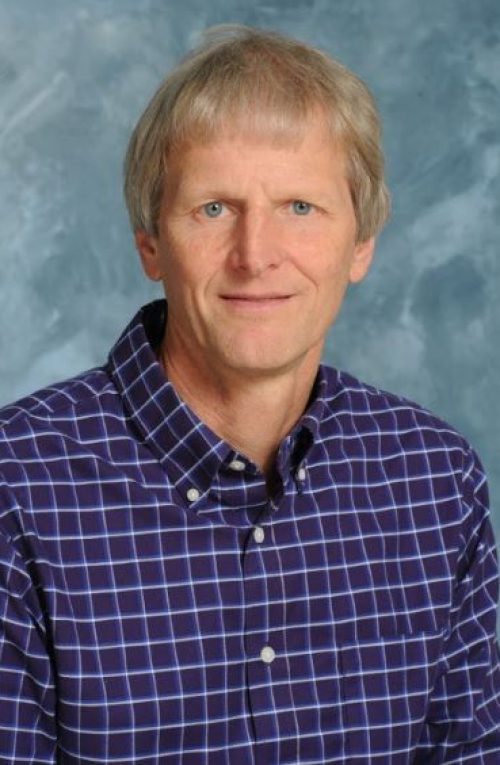Halard L. Lescinsky

Professor
Dr. Halard Lescinsky is a coral reef ecologist, paleontologist, and field geologist. He directs the Aquarium track within the Zoo and Conservation Science Program, and leads travel courses to Belize (coral reefs and rainforest) and to the desert southwest (field geology). He teaches a variety of courses including coral reef ecology, evolution, historical geology, marine science, and field geology. His research explores coral reefs and how their recent geologic record and fossils can help us understand reef processes and how they respond to recent environmental challenges.
Education
- PhD, Geology, University of California, Davis
- BA, Geology, Williams University
Publications
- Irwin A, Greer L, Humston R, Devlin-Durante M, Cabe P, Lescinsky H, Wirth K, Curran HA, Baums I (2017) Age and intraspecific diversity of resilient Acropora communities in Belize. Coral Reefs: 10.1007/s00338-017-1602-9
- Lescinsky, HL (2016) Living and mineral reefs: Are they comparable and what ecological information is preserved? Pgs 225-259 in Hubbard, D (Ed.) Coral Reefs at a Cross Roads, Springer Science.
- Busch, J., Greer, L., Harbor, D., Wirth, K., Lescinsky, H., and Curran, H.A., (2016) Quantifying exceptionally large populations of Acropora spp. corals in Belize using sub-meter satellite imagery classification. Bulletin of Marine Science, v.92, pp. 265-283. http://dx.doi.org/10.5343/bms.2015.1038
- Greer, L., Lescinsky, H., and Wirth, K. (2016) Multi-level characterization of acroporid coral populations at Coral Gardens, Belize: A refugia identified. Proceedings of the 28th Annual Keck Research Symposium. Schenectady, New York, USA. http://www.keckgeology.org/publications, 6 p.
- Martin, Z and Lescinsky H (2016) Are threespot damselfish helping or hurting the possible resurgence of acropora corals? Proceedings of the 28th Annual Keck Research Symposium. Schenectady, New York, USA. http://www.keckgeology.org/publications
- Hubbard D, E Gischler, P Davies, L Montaggioni, G Camoin, W Dullo, C Storlazzi, M Field, C Fletcher, E Grossman, C Sheppard, H Lescinsky, D Fenner, J McManus, S Scheffers, (2014) Island Outlook warm and swampy, Science 345:1461.
- McElroy, C and Lescinsky,L (2013) Post-bleaching encrustation habits in USVI coral reefs. Proceedings of the 25th Annual Keck Research Symposium. Amherst MA. Pp 200-206.
- Lescinsky HL (2012) Partial mortality and re-sheeting in fossil corals: a disease proxy, ICRS Proceedings ICRS2012_2B_3
- Lescinsky, HL, Titus, B, and D Hubbard, (2012) Live Coral Cover in the Fossil Record: An Example from Holocene Reefs of the Dominican Republic, Coral Reefs 31:335-347.
- Jessen-Marshall, A and HL Lescinsky, (2011) Origins: Team Teaching in the Sciences , pgs. 13-35 In Plank, K.M. Team Teaching: Across the Disciplines, Across the Academy, Stylus Publishing, Sterling VA.
- Lescinsky, HL, M. Hill and B.A. Hoedt, 2008, Results of long-term bioerosion study: Belize patch reefs, ICRS Proceedings 11:26-30.
- Lescinsky, H.L., 2008, Bioerosion and encrustation on Curacao Pleistocene reefs: evaluating grazing in the fossil record, Geology of the Bahamas and other Carbonate Regions, 13: 197-210.
- Pandolfi, J.M., A.M. Tudhope, G. Burr, J. Chappell, E. Edinger, M. Frey, R. Steneck, C. Sharma, A. Yeates, M. Jennions, H. Lescinsky, and A. Newton, 2006, Mass mortality following disturbance in Holocene coral reefs from Papua New Guinea, Geology 34:949-952.
- Lescinsky, H.L., 2004. Bioerosion in the Caribbean: using coral bleaching as a natural experiment, Geology of the Bahamas and other Carbonate Regions, 11: 25-34.
- Lescinsky, H.L., Edinger, E. and M. Risk. 2002. Mollusc shell encrustation and bioerosion rates in a modern epeiric sea: taphonomy experiments in the Java Sea, Indonesia. Palaios 17:171-191.
- Lescinsky, H.L., 2001. Epibionts. pgs. 464-468 In Briggs, D. and Crowther, P. (eds.) Paleobiology II. Blackwell Press.
- Salak, M. and H.L. Lescinsky, 1999. Spygoria zappania, new genus and species, a Cloudina-like biostromal metazoan from the Lower Cambrian of central Nevada. Journal of Paleontology 73:571-576.
- Lescinsky, H.L., 1997, Epibiont communities: recruitment and competition on North American Carboniferous brachiopods. Journal of Paleontology 71:34-53.
- Lescinsky, H.L., 1996. Early brachiopod associates: epibiont communities on Middle Ordovician brachiopods. pg. 169-173 In Copper, P and J. Jin (eds.) Proceedings of the Third International Brachiopod Congress. Balkema Press.
- Lescinsky, H.L, 1996. Don't overlook the epibionts! Palaios 11(6):1-2.
- Lescinsky, H.L., 1995. The life orientation of concavo-convex brachiopods: overturning the paradigm. Paleobiology 21:520-551.
- Lescinsky, H.L., and L. Benninger, 1994. Pseudo-borings and predatory traces: artifacts of pressure dissolution in fossiliferous shales. Palaios 9:599-604.
- Vermeij, G.J., H.L. Lescinsky, E. Zipser, and H.E. Vermeij, 1994. Diet and mode of feeding of the muricid gastropod Acanthinucella lugubris angelica in the northern Gulf of California. The Veliger 37:214-215.
- Lescinsky, H.L., 1993. Taphonomy and paleoecology of epibionts on the scallops Chlamys hastata (Sowerby 1843) and Chlamys rubida (Hinds 1845). Palaios 8:267-277.
- Lescinsky, H.L., J. Ledesma-Vazquez, J., and M.E. Johnson, 1991. Dynamics of a Late Cretaceous Rocky Shore (Lower Rosario Formation) from Baja California, Mexico. Palaios 6:126-141.
- Johnson, M.E., and H.L. Lescinsky, 1986. Depositional dynamics of cyclic carbonates from the Interlake Group (Lower Silurian) of the Williston Basin. Palaios 1:111-121.